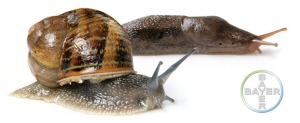| |
A growing threat...
 Lungworm
has been known in the UK for some 20 years, especially in hot spots such as Surrey, South Wales
and Cornwall, but in the last two years, it has become a more widespread and common threat, due
to a variety of factors. These include global warming, an increasing and more urban-based fox
population as well as the decrease in the use of slug bait and other poisons. This article by
vet Peter van Dongen describes the life cycle of the worm, the symptoms, diagnosis and
treatment of this serious threat to your canine friend, and, more importantly, how you can
avoid the disease affecting your best friend! Lungworm
has been known in the UK for some 20 years, especially in hot spots such as Surrey, South Wales
and Cornwall, but in the last two years, it has become a more widespread and common threat, due
to a variety of factors. These include global warming, an increasing and more urban-based fox
population as well as the decrease in the use of slug bait and other poisons. This article by
vet Peter van Dongen describes the life cycle of the worm, the symptoms, diagnosis and
treatment of this serious threat to your canine friend, and, more importantly, how you can
avoid the disease affecting your best friend!
Lungworm, aka 'French Heartworm', caused by the
nematode (a type of worm) Angiostrongylus Vasorum, is a potentially fatal condition affecting
dogs and foxes. It is not to be confused with 'Heartworm' caused by Dirofilaria Immitis, a
disease not endemic in the UK.
 Lifecycle Lifecycle
Adult worms live in the right side of the heart and great pulmonary vessels. Eggs are laid
and move, via the blood vessels, to the lungs, where they hatch larvae, which are coughed up
and swallowed.
They are then passed in the dog's faeces and eaten by slugs and snails
(intermediate hosts), where they undergo further development. Dogs, foxes and frogs (paratenic
host) then eat the slugs or snails - and dogs and foxes eat those frogs as well - and the
larvae are absorbed from the gut into the blood stream, after some more development, from where
they end up in the heart again.
It sounds incredible but this is what actually happens. The whole process takes
about 1-2 months in total. Dogs can get infected by accidentally eating the intermediate hosts,
for instance when they eat grass - some slugs are tiny! Dogs can, in fact, also be infected
through slime trails, for instance on garden patios or on outside water bowls.
Symptoms
There are three groups of symptoms:-
-
Cardio-respiratory - Involving the heart and lung systems. It can show as coughing,
difficulty breathing, fast breathing, exercise intolerance etc.
-
Neurological - Involving the nerve system. It can show as paralysis, fits, unco-ordination,
spine pain or even behavioural changes.
-
Coagulopathy - A blood clotting disorder. It can show as bleedings in the skin and excessive
bruising, prolonged wound bleeding, nose bleeds, pale mucous membranes, bleeding in the eye.
All ages of dog can be affected, but often it affects young dogs, say under 2
years of age. There is no breed predilection. Lungworm is a very dangerous condition, which, if
untreated, can lead to a dog's death!
 Diagnosis Diagnosis
Diagnosis is based on a combination of things. The signalment including dog's breed, sex,
age, lifestyle, behaviour and home circumstances etc., history and clinical symptoms might lead
to your vet suspecting the disease. He or she may then do various tests on your dog, including
blood tests, x-rays, lung flush samples (BAL) or other. Unfortunately, none of these are
specific.
The best test is a Baermann test on the dog's faeces, often done at an outside
laboratory, but sometimes on the vet's premises. It often takes a '3-day-poo-sample' (i.e. poos,
collected on three consecutive days). Sometimes it is impossible to get a definitive diagnosis
and some cases are treated on a strong suspicion, rather than a proven diagnosis.
|
Treatment
As lungworm is potentially life threatening, if infection is proven, or even strongly
suspected, immediate treatment is advised. The only licensed veterinary treatment to this
purpose, at the moment, is an imidacloprid / moxidectin combination (called 'Advocate*'), given
as a spot-on treatment. Another treatment is available, in the form of a tablet, containing a
milbemycin oxime / praziquantel combination (called Milbemax*'), but it only 'reduces the level
of infection'. Fenbendazole ('Panacur*', 'Granofen*') has also been used, usually in the form
of a paste or granules, but needs to be administered for at least 7, and often 20, subsequent
days to have a similar effect to a single spot-on treatment. Other supportive treatments may be
needed at the same time, depending on the dog's condition. In-contact dogs should also be
treated at the same time.
Efficacy
of the spot-on treatment is 85% after one application, and 100% after the second treatment, one
month later. The Advocate spot-on treatment also deals with fleas, flea larvae, biting lice,
heartworm, roundworm, hookworm, whipworm, fox mange, ear mites and puppy mange! (It does not
deal with ticks or tapeworms though.)
 Prevention Prevention
The simple answer to the question of how to try and prevent your dog from getting any of
the parasites, mentioned above, but especially lungworm, is to use Advocate spot-on on a
monthly basis! It is currently the only safe way of protecting your dog against this
potentially lethal parasite. I use it on my own two dogs every month! And for those people,
worrying about the use of this product on Collies, or their crosses, there is good news:
Advocate is safe to use on all breeds of dogs from seven weeks of age onwards!
To see a short video about the lungworm's life cycle, go to:
http://www.youtube.com/watch?v=gHgmIc4Vbrw&feature=player_embedded
|
Preventing Lungworm
 Imagine my horror last year when my youngster started showing symptoms of
Lungworm. She was treated quickly and effectively, but my vet shocked me by pointing out
that the parasite can be picked up merely by eating grass with a slime trail on it, or by
drinking out of a puddle with infected slime trail in it. Imagine my horror last year when my youngster started showing symptoms of
Lungworm. She was treated quickly and effectively, but my vet shocked me by pointing out
that the parasite can be picked up merely by eating grass with a slime trail on it, or by
drinking out of a puddle with infected slime trail in it.
So now I treat my dogs monthly with the dreaded Advocate - dreaded because I
hate putting heavy chemicals on them. I also discourage grass eating and always
carry a bottle of water and a great little device called the
Pocket Puddle with me.
Pocket puddles small and light, and the dogs are happy to drink out of
them. All I have to do is shake it out and ask 'Who wants a drink?' They come over
and dive in. No more drinking out of gunky puddles, full of algae and invisible slime
trails!
Fran Walton |
 About the author... About the author...
Pete van Dongen, Drs.(Utrecht), Cert.V.R, MRCVS
qualified as a vet at the Utrecht
Veterinary school, The Netherlands, in March 1990. He worked in a mixed practice in Louth,
Lincolnshire, UK, for three years, before deciding to limit himself to small animals only.
In 1993 he joined Pennard Veterinary Group, in Sevenoaks, Kent. From December
1996 till January 2005 he ran his own branch practice in Allington, Maidstone. Currently he is
a Director at Pennard Veterinary Group, now a 13 vet, four branch, small animal veterinary
practice. His special interests are surgery, orthopaedics, radiology and, more recently, Canine
Sports Medicine. He has just set up a hydrotherapy service at his practice.
In May 1995 Peter started agility - after years of just thinking about it - with
his Jack Russell X 'Basil' (a bitch!), then five years old. Since then they qualified for many
finals, including Crufts and Olympia. Basil won the coveted Crufts 2001 title in the individual
Mini agility. Peterís little Jack Russell X, Sky, is now at Grade 6 and has recently taken part
in the European Open Agility Championships.
Peter passed the British Agility Club Instructors' exam in October 1999 (first
class) and then did the British Agility Club Judging Workshop.
Peter regularly writes for various agility magazines and web sites and has been
the official British Team Vet for the Agility World Championships for the last seven years.
Since 2006 Peter has started to do yearly charity treks, first to the
Norwegian arctic (2006), then to
the Namibian desert (2007),
then to Machu Picchu (2008) in Peru and
this year to Mount Kilimanjaro in Tanzania (2009).
The Pocket Puddle is available from
Agility Warehouse
First publisher 19 June 2009
| |
|
 About the author...
About the author...